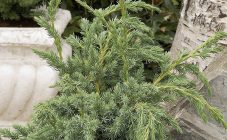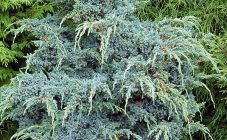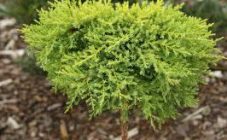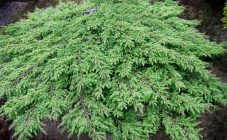Content:
Sometimes the common forest juniper is called the northern cypress. The plant amazes with its graceful appearance and splendor. Since it is evergreen, it can be used to create beautiful garden compositions throughout the year. Gardening enthusiasts will be interested in learning how to transplant a juniper from a forest to a site.
Juniper description
Over 70 species of juniper grow in the Northern Hemisphere. The fruits of some of them have medicinal properties. Trees can reach a height of 18 m. There are shrub species. The needles are prickly, each whorl contains 3 needles.
"Flowers" appear in spring, mainly in April. By the fall, pine berries grow in their place. After a year, they become soft, with a bluish bloom. These cone berries contain seeds that are hard-shelled. On each shrub, one-year green and two-year blue cones with a bitter taste can ripen at the same time.
The roots of the plant are superficial, which is why they often die during forest fires or are damaged by pests. Junipers in the forest can grow on different soils. All its types differ in different crown shapes, height. Trees are well adapted to trimming and decorative crown changes. The benefit of a haircut is that it is able to heal the branches, and fights disease.
Cones are used in folk medicine as a remedy for many diseases. It gives off a pleasant aroma that protects against disease-causing bacteria. Therefore, it is advisable to breed it in any country or garden economy.
Juniper transplant
In order for this plant to take root in the garden or in the country, it must be carefully transplanted. Growing certain varieties of the plant can be difficult. Therefore, in order for the plant to please the eye near the house, certain tips should be followed.
Site preparation
A properly prepared soil is necessary for the plant. Depending on the species, either alkaline or acidic soil is required. To reduce its acidity at home, you should add a little slaked lime or dolomite flour. To acidify the soil, peat is introduced into it. It is preferable to mulch it with sawdust.
For the Siberian forest juniper in the garden, you need to choose a sandy soil. The Virginian species prefers loams.
Natural drainage is added to the planting pit, which consists of broken bricks, pebbles and coarse sand. Its thickness should be about 25 cm.
It is forbidden to plant a tree near buildings. This is due to the fact that snow and water fall from them in winter and early spring. They damage the delicate crown.
Planting process
A plant brought from the forest can take root only if all planting rules are observed:
- A wild-growing juniper is transplanted at the end of winter, when the ground has a little more snow. This applies to all plant species.
- While digging out the tree, a ribbon is attached to the side where the sun was shining.On the site, the wild forest juniper must be planted in the same position so that the ribbon shows the direction to the sun. It is better to carry out the transplant process on a sunny day.
- When digging up a tree, you need to save as much land as possible on the root system. Moreover, it should be sufficient in depth and width.
- It is forbidden to transport a seedling without protection (the earth is wrapped in paper, a package). If this is not done, then a clod of earth may crumble, and the tree will not take root.
- The juniper is planted in holes or trenches.
- The hole for the tree should be the same size as the clod of earth. Do not bury the root collar of the plant.
- The tree should only be planted in fertile soil. During planting, the roots need to be flattened a little and lightly sprinkled with earth. From above it is sprinkled with a mixture of wet sawdust and pine needles.
- From the soil left during planting, you need to make a small roller around the edges. Inside you need to pour 2 buckets of water and another bucket with a tablet of heteroauxin.
Can I buy wood
You can buy it dug out or in a pot. Such a plant should be planted in spring or autumn. If the tree was in the container, then planting is carried out at any time of the year. Only young seedlings are suitable for transplanting - old trees will not take root well in a garden.
Care
This plant does not require serious maintenance.
At the same time, simple rules must be followed:
- in the spring you need to feed the plant;
- the circle near the trunk must be kept in clean conditions, weed and mulched;
- mulch is placed on geotextile;
- in winter, the crown is tied with twine, because snow comas can ruin the appearance of the plant;
- varieties with blue needles should be protected from the sun by covering the plant with an opaque material;
- you need to prune the plant in a timely manner and remove dead branches (so new ones will begin to grow faster;
- young branches must be protected from frost.
Young plants need watering. Adults tolerate drought conditions well. Water the plants up to 3 times a month. In hot weather, they are sprayed 1 time within 10 days. About 1-3 buckets of water go to the tree for irrigation.
Pruning a plant is carried out in case you need to make a green hedge out of it. In other cases, trimming is not carried out. When pruning, you need to be extremely careful not to remove excess shoots - it will take a very long time to recover. It is necessary to carry out sanitary pruning, it does not damage the crown of the plant and does not cause further disease.
Juniper in the suburbs
This tree grows in many forests of the Moscow region. You can dig up and transplant forest junipers in the Moscow region in all areas of the region.
Juniper in the suburbs tolerates winter conditions well. If young trees are dug, then for the winter they need to be covered with spruce branches.
In the Moscow region, you can transplant a juniper in the Urals in the forest. Conditions for its growth will be favorable in the Moscow region, especially in mild winters. All Siberian and Ural varieties take root well in central Russia, with proper care they are not affected by dangerous pests.
Diseases and pests
This plant can suffer from such diseases and pests:
- Rust. With her, the needles acquire a yellow tint. It is treated with Arsedir solution.
- Schütte's disease.
- Gray mold is harmful to young shoots.
- Juniper moth. It is treated with the drug Decis.
- Spider mite (you can get rid of it with the help of the Karate preparation).
- Shield.
- Aphids (affects young shoots, to get rid of the disease, the plant should be sprayed with Fitoverm).
Juniper is a real forest decoration for a garden or summer cottage. It is very easy to care for the plant, it is resistant to diseases. Some of its types are an effective medicine against many diseases.















